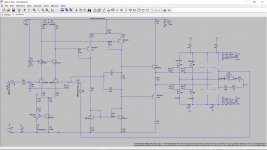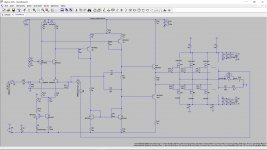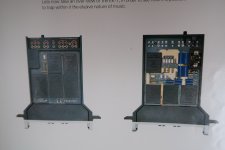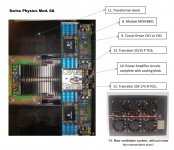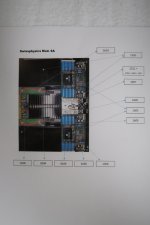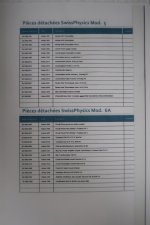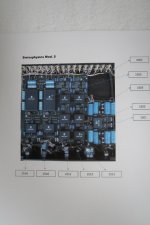Use Goldmund.Chaps,
Does anyone have a copy of the 6A schematics?
Cheers,
Horacio
Had one Swiss, so i kinda know it.
My comments were based upon these thoughts:
The main circuit is mostly based upon a Hitachi Application Note as a sales pitch for their (then) newly introduced MOSFET power transistor. Where most other manufacturers chose the "easy" route with only five transistors in front of the Power MOSFETs, SP chose otherwise even though they didn`t achieve much more.
When they (SP) were introduced to the Norwegian audio scene ooodles of years ago, they actually came at half price because they were already bankrupt.
Which lead up to "state your worries" as an invitation for you to describe the (potential) problems so that maybe diyaudio as a collective could actually help you mend them.
I have complete schematics for their Model 5 preamp, so I know that most crucial parts are potted and NOT described in those schematics, much to the annoyance of those customers who have bought SP, and also other amps of likewise "shrouded" products.
But hey, I`m Norwegian, maybe I just don`t know how to express myself in English, even though the mother of my children is American.
Regards
Roar Malmin
The main circuit is mostly based upon a Hitachi Application Note as a sales pitch for their (then) newly introduced MOSFET power transistor. Where most other manufacturers chose the "easy" route with only five transistors in front of the Power MOSFETs, SP chose otherwise even though they didn`t achieve much more.
When they (SP) were introduced to the Norwegian audio scene ooodles of years ago, they actually came at half price because they were already bankrupt.
Which lead up to "state your worries" as an invitation for you to describe the (potential) problems so that maybe diyaudio as a collective could actually help you mend them.
I have complete schematics for their Model 5 preamp, so I know that most crucial parts are potted and NOT described in those schematics, much to the annoyance of those customers who have bought SP, and also other amps of likewise "shrouded" products.
But hey, I`m Norwegian, maybe I just don`t know how to express myself in English, even though the mother of my children is American.
Regards
Roar Malmin
Basic Goldmund even relay controls are the same.
There is a lot of treads here abt Goldmund, search and find.
I have the dravings somwhere, but remember it iknoff to fix without.
Voltage doubling then regulated for input voltage and driver stage. Output has 4 ' 1000uF for each half..... Somwhere i have the s
Here is basic of amplifier stage:
There is a lot of treads here abt Goldmund, search and find.
I have the dravings somwhere, but remember it iknoff to fix without.
Voltage doubling then regulated for input voltage and driver stage. Output has 4 ' 1000uF for each half..... Somwhere i have the s
Here is basic of amplifier stage:
Attachments
My comments were based upon these thoughts:
The main circuit is mostly based upon a Hitachi Application Note as a sales pitch for their (then) newly introduced MOSFET power transistor. Where most other manufacturers chose the "easy" route with only five transistors in front of the Power MOSFETs, SP chose otherwise even though they didn`t achieve much more.
When they (SP) were introduced to the Norwegian audio scene ooodles of years ago, they actually came at half price because they were already bankrupt.
Which lead up to "state your worries" as an invitation for you to describe the (potential) problems so that maybe diyaudio as a collective could actually help you mend them.
I have complete schematics for their Model 5 preamp, so I know that most crucial parts are potted and NOT described in those schematics, much to the annoyance of those customers who have bought SP, and also other amps of likewise "shrouded" products.
But hey, I`m Norwegian, maybe I just don`t know how to express myself in English, even though the mother of my children is American.
Regards
Roar Malmin
Dear Roar,
No hard feelings, I understand your point of view.
Since the 6A does not have the case with the mini fans I am trying to find some information in order install after market fans using the fan supply outlet on the rear panel.
When I purchased this amp I knew what I was getting into and took a risk. Sometimes I knew that I was being taken for a ride but after more than fifty years buying, selling and trading audio equipment as a hobby, I could not resist the temptations.
I bought my first system in 1962 - Leak Point One and TL50, Tannoy Monitor Golds, 401/SME/Ortofon.
I met Mauro del Nobile and his wife Nadejda unexpectedly when we were living in Brussels and was on my way to Luzern to pick up my Breuer tonearm. He was a brilliant engineer that started Goldmund together with Michel Reverchon, the collaboration didn't go so well, del Nobile was not a businessman, he left and started SwissPhonics.
Many components had been using potted crucial parts, Audio Research [SP-4] used the Analog Module, they referred to it as a device that acts as a "super tube" but in my opinion it was nothing but a good IC made by Honeywell. My Levinson ML-1 had encapsulated - potted - amplifier modules.
John Iverson fabulous Electro Research Electro Kinetic EK-1 strain gauge type preamp using the Panasonic EPC-451C cartridge had all the modules potted, please see photo. Iverson was also a brilliant designer and like del Nobile he was not a businessman either, his company folded like SP.
On another note, I purchased the SP to compare it with my superb Electrocompaniet 100 DMB anniversary amp.
Ciao,
Horacio
Attachments
Swiss Physics preamp and power amp Del Nobile
Found this thread by coincidence. A few remarks:
- Repair of the power amp is possible without schematic most of the time.
I do not own a schematic.
- Have a look at loose heat sink screws on TO3 devices. Have a special
look at Philips electrolytic caps.
- On one or two of the amp boards there is a tiny ground trace routed (IIRC
near board edge) and burnout of this slim copper trace leads to malfunction.
- As far as the fans are concerned, these are standard slimline and operating
with reduced voltage. I do not think you need them if you operate the amp
without the wooden cabinet.
- When working on the preamp exchange rectifiers. These are too small and
the transformer can be destroyed if they burn out. I had to replace one
transformer in the past.
- Pay special attention to Philips caps in the preamp also.
- If one of the small modules in the preamp is faulty you may want to use a working
module from the "inverted gain" section, rewiring the amp so that "out of phase"
operation is no longer possible. This is cumbersome work however.
- Opened one module and noted the circuitry somewhere, I will be able to find it.
- The big phono mc module is different. It rarely fails. I think I opened one and
decided to replace the circuit with something else. Please note : operation of
the mc stage depends heavily on some big Philips electrolytics.
Found this thread by coincidence. A few remarks:
- Repair of the power amp is possible without schematic most of the time.
I do not own a schematic.
- Have a look at loose heat sink screws on TO3 devices. Have a special
look at Philips electrolytic caps.
- On one or two of the amp boards there is a tiny ground trace routed (IIRC
near board edge) and burnout of this slim copper trace leads to malfunction.
- As far as the fans are concerned, these are standard slimline and operating
with reduced voltage. I do not think you need them if you operate the amp
without the wooden cabinet.
- When working on the preamp exchange rectifiers. These are too small and
the transformer can be destroyed if they burn out. I had to replace one
transformer in the past.
- Pay special attention to Philips caps in the preamp also.
- If one of the small modules in the preamp is faulty you may want to use a working
module from the "inverted gain" section, rewiring the amp so that "out of phase"
operation is no longer possible. This is cumbersome work however.
- Opened one module and noted the circuitry somewhere, I will be able to find it.
- The big phono mc module is different. It rarely fails. I think I opened one and
decided to replace the circuit with something else. Please note : operation of
the mc stage depends heavily on some big Philips electrolytics.
6a and the fan problem
I used a 6a for many years. Now it is in storage, the repair shop suspects an imbalance they cant find or fix. But the fan problem was within my abilities :
1. I bought 6 top quality (=silent) Pabst fans and threw out the old ones
2. Threw away the small power supply (burnt anyway)
3. Used a standard PC powersupply as external power. Found one with regulation.
Then airflow can be regulated and not necessary to regulate until the noise is a problem. But it is necessary to put 2 switches to "on", amp and cooling.
Maybe I should give it another chance ? (Now I use an Ayre 5)
Thor Ø
Since the 6A does not have the case with the mini fans I am trying to find some information in order install after market fans using the fan supply outlet on the rear panel.
I used a 6a for many years. Now it is in storage, the repair shop suspects an imbalance they cant find or fix. But the fan problem was within my abilities :
1. I bought 6 top quality (=silent) Pabst fans and threw out the old ones
2. Threw away the small power supply (burnt anyway)
3. Used a standard PC powersupply as external power. Found one with regulation.
Then airflow can be regulated and not necessary to regulate until the noise is a problem. But it is necessary to put 2 switches to "on", amp and cooling.
Maybe I should give it another chance ? (Now I use an Ayre 5)
Thor Ø
Since the 6A does not have the case with the mini fans I am trying to find some information in order install after market fans using the fan supply outlet on the rear panel.
Why two switches? If Youre series connect fans you wil have abt 10 V each or use bouth positive and negative supply then you have 120v for youre 6 * 24V fans. WITHOUT regulator getting hot running all fans at 12v with 60V input.6a and the fan problem
I used a 6a for many years. Now it is in storage, the repair shop suspects an imbalance they cant find or fix. But the fan problem was within my abilities :
1. I bought 6 top quality (=silent) Pabst fans and threw out the old ones
2. Threw away the small power supply (burnt anyway)
3. Used a standard PC powersupply as external power. Found one with regulation.
Then airflow can be regulated and not necessary to regulate until the noise is a problem. But it is necessary to put 2 switches to "on", amp and cooling.
Maybe I should give it another chance ? (Now I use an Ayre 5)
Thor Ø
Since the 6A does not have the case with the mini fans I am trying to find some information in order install after market fans using the fan supply outlet on the rear panel.
The fan down is basically a question, cause the AB bias setting for latheral mosfets.
The switch two ore three speed or thermal down (NTC) fan speed in series with the fan power output, rear of the amp. Maybee a combination will bee the best solution.
A lot of fans today leaves the original in the dust when compearing fan noice versus flow.
You may give the slises for air flow out a thought about flow resistence, also gives less fan power another chance.
One of my frends modifyed his with a low noice single fan 10-12 cm.
Are yout thoughtts about usin 220v ac fan?
Also on/at the sides of transformers there is a room for placing output stage increased capasitor bank. if you feel for it
Last edited:
- Home
- Amplifiers
- Solid State
- Swiss Physics 6A
